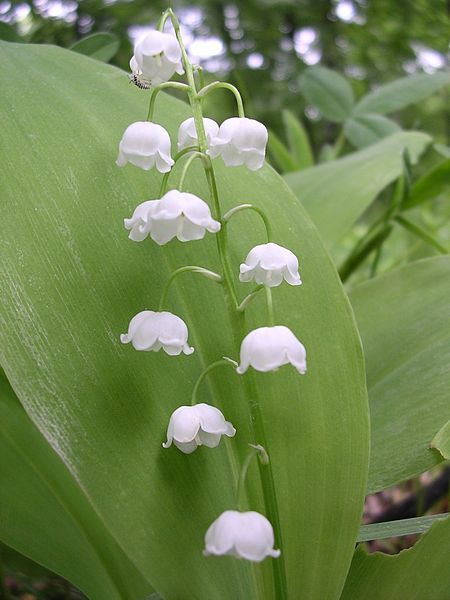
Convallaria majalis
or
Lily of the Valley
H. Zell,
Wikimedia Commons, 2009.
Those beautiful flowers above look like upside-down tea cups, do they not? However, those floral white cups are not something you'd like to take a drink out of. Convallaria majalis, commonly known across North Americas and Europe as Lily of the Valley, contains deadly toxins that interfere with electrical functions within the heart. There is so much more to know about these deadly toxins before you go off and hate this beautiful monocot for just being unique!
Despite its potential to harm, Lily of the Valley is an extremely typical and common garden plant. It gives off a sweet and fragrant smell, which only adds to the allure of the plant's simple beauty. Did you know that Convallaria majalis even has a Biblical connection to Easter? Find out more fascinating facts about this unique herb.
The Latin specific epithet (or Latin name or scientific name) likely evolved from 'convallis', meaning deep valley and 'maius' meaning May. 'The flower found in deep valleys that blooms in May' incorporates these meanings and eloquently describes Convallaria majalis and one of its habitats. For more information on where, how, and why Lily of the Valley is classified, click here.

Olegivvit, Wikimedia Commons.
H. Zell, Wikimedia Commons, 2009.
GENERAL CHARACTERISTICS
Lily of the Valley, if found during its flowering season, is
extremely easy to identify. Even if found while it is not flowering,
most people with a small amount of knowledge about the plant could
pick it out. The notable and distinctive white flowers consist of
six fused petals. Usually there are about six to twelve petals along
each side of the fragile stalks. Accompanying these bell-shaped
flowers are two or three large, oval, waxy leaves. Many of these
structures are major players in the plant's
life cycle. During the fall
months, mostly in September, Convallaria majalis bears tiny
orange-red berries. They look scrumptious, but you do not want to
eat these little guys!
This webpage was created by Hayley Powers, a student of the University of Wisconsin La Crosse in 2013. It was last edited Friday, April 19th, 2013.
Not the organism you were looking for? Want to know more about other organisms? Visit MultipleOrganisms.net, a collection of original web pages about organisms created by other students of the University of Wisconsin La Crosse.
So now you know a little bit about Convallaria majalis, make sure you find out how it is classified in the phylogenetic tree.